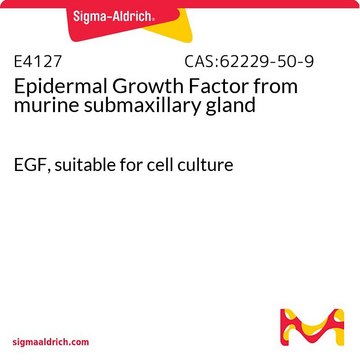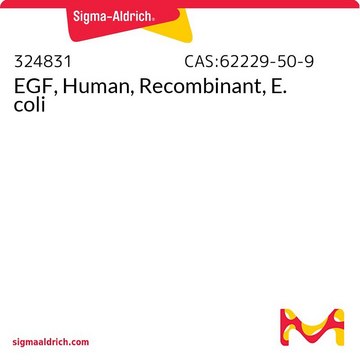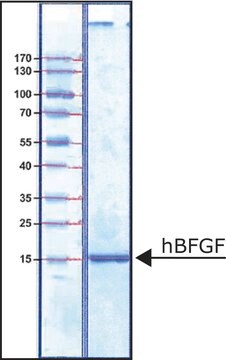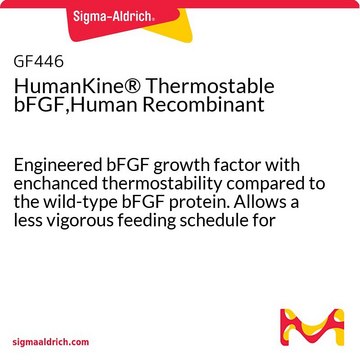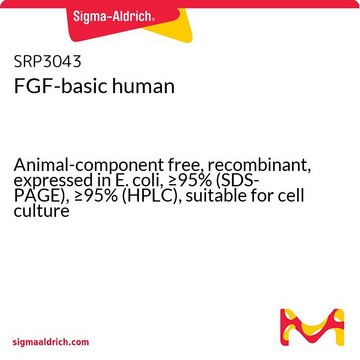SRP3027
EGF human
Animal-component free, recombinant, expressed in E. coli, ≥98% (SDS-PAGE), ≥98% (HPLC), suitable for cell culture
Synonyme(s) :
Epidermal Growth Factor, URG, Urogastrone
Se connecterpour consulter vos tarifs contractuels et ceux de votre entreprise/organisme
About This Item
Code UNSPSC :
12352202
Nomenclature NACRES :
NA.32
Produits recommandés
Source biologique
human
Produit recombinant
expressed in E. coli
Essai
≥98% (HPLC)
≥98% (SDS-PAGE)
Forme
lyophilized
Puissance
≤0.2 ng/mL
Poids mol.
6.2 kDa
Conditionnement
pkg of 500 μg
Technique(s)
cell culture | mammalian: suitable
Impuretés
<0.1 EU/μg endotoxin, tested
Couleur
white to off-white
Numéro d'accès UniProt
Conditions d'expédition
wet ice
Température de stockage
−20°C
Informations sur le gène
human ... EGF(1950)
Description générale
The gene EGF (epidermal growth factor) is mapped to human chromosome 4q25-27. The EGF gene encodes for a large type I membrane–anchored precursor protein which is cleaved into pro-EGF for generation of peptide hormone EGF. The mRNA is expressed in kidney, salivary gland, cerebrum and prostate. Recombinant human EGF is a 6.2kDa globular protein containing 53 amino acid residues including 3 intramolecular disulfide-bonds.
Application
EGF (epidermal growth factor) human has been used in the culture medium for the maintenance of MCF10A cells (human mammary epithelial cells).
Actions biochimiques/physiologiques
EGF (epidermal growth factor) is a potent growth factor that stimulates the proliferation of various epidermal and epithelial cells. Additionally, EGF has been shown to inhibit gastric secretion, and to be involved in wound healing. EGF signals through a receptor known as c-erbB, which is a class I tyrosine kinase receptor. This receptor also binds with TGF (transforming growth factor)-α and VGF (vaccinia virus growth factor). Mutation in the EGF gene might be associated with risk of non- small cell lung adenocarcinoma. It is also involved in anaplastic thyroid cancer and renal hypomagnesemia. It controls cell differentiation and neurotrophic processes.
Séquence
NSDSECPLSH DGYCLHDGVC MYIEALDKYA CNCVVGYIGE RCQYRDLKWW ELR
Forme physique
Lyophilized with no additives.
Reconstitution
Centrifuge the vial prior to opening. Reconstitute in water to a concentration of 0.1-1.0 mg/ml. Do not vortex. This solution can be stored at 2-8°C for up to 1 week. For extended storage, it is recommended to further dilute in a buffer containing a stabilizer (example 5% Trehalose) and store in working aliquots at -20°C to -80°C.
Code de la classe de stockage
11 - Combustible Solids
Classe de danger pour l'eau (WGK)
WGK 3
Point d'éclair (°F)
Not applicable
Point d'éclair (°C)
Not applicable
Faites votre choix parmi les versions les plus récentes :
Déjà en possession de ce produit ?
Retrouvez la documentation relative aux produits que vous avez récemment achetés dans la Bibliothèque de documents.
Les clients ont également consulté
Basal p21 controls population heterogeneity in cycling and quiescent cell cycle states.
Overton KW
Proceedings of the National Academy of Sciences of the USA, 111, E4386-E4393 (2014)
Clinical Implication of EGF A61G Polymorphism in the Risk of Non Small Cell Lung Adenocarcinoma Patients: A Case Control Study.
Masroor M
Asian Pacific Journal of Cancer Prevention, 16, 7529-7534 (2015)
The miR-200 family regulates the epithelial-mesenchymal transition induced by EGF/EGFR in anaplastic thyroid cancer cells.
Zhang Z
International Journal of Molecular Medicine, 30, 856-862 (2012)
Neurotrophic actions of a novel molluscan epidermal growth factor.
Hermann PM
The Journal of Neuroscience, 20, 6355-6364 (2000)
Epidermal growth factor therapy and wound healing--past, present and future perspectives.
Hardwicke J
The Surgeon : Journal of the Royal Colleges of Surgeons of Edinburgh and Ireland, 6, 172-177 (2008)
Notre équipe de scientifiques dispose d'une expérience dans tous les secteurs de la recherche, notamment en sciences de la vie, science des matériaux, synthèse chimique, chromatographie, analyse et dans de nombreux autres domaines..
Contacter notre Service technique
